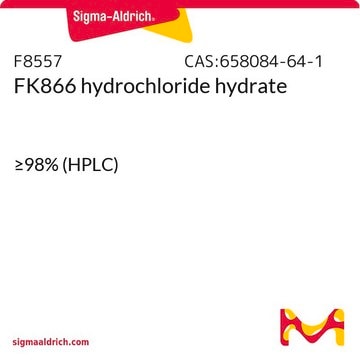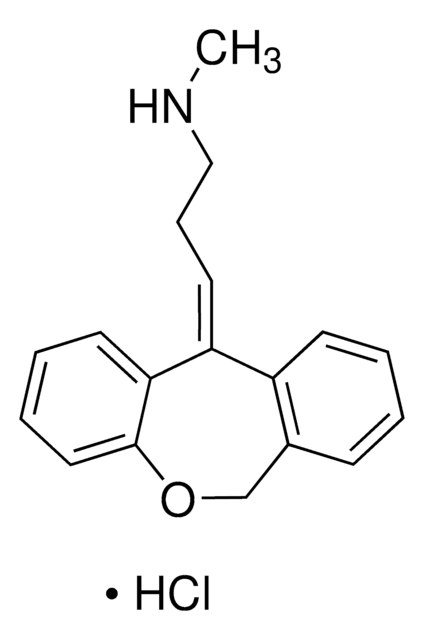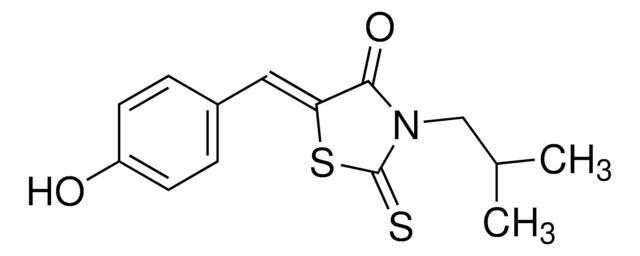SML3867
BI, Broccoli Fluorophore
≥98% (HPLC)
同義詞:
(5Z)-3-(1H-Benzimidazol-7-ylmethyl)-5-[(3,5-difluoro-4-hydroxyphenyl)methylene]-3,5-dihydro-2-methyl-4H-imidazol-4-one, (Z)-3-((1H-Benzo[d]imadazol-4-yl)methyl)-5-(3,5-difluoro-4-hydroxybenzylidene)-2-methyl-3,5-dihydro-4H-imidazol-4-one, BI, DFHBI-BI
登入查看組織和合約定價
全部照片(2)
About This Item
暫時無法取得訂價和供貨情況
推薦產品
生化/生理作用
Cell-permeable DFHBI derivative that selectively binds to Broccoli aptamer; used for imaging of RNA in living cells.
BI is a cell-permeable DFHBI benzimidazolo (DFHBI-BI) derivative that greatly and selectively promotes and stabilizes Broccoli aptamer folding in vitro and cells with enhanced photostability. BI displays little background in vitro and cells (ϕ=0.00048, ϵ=42,500 M−1 cm−1), but very high fluorescence activation after binding to Broccoli (ϕ=0.669, ϵ=33,600 M−1 cm−1, KD = 51 nM). DFHBI-BI shows negligible cellular toxicity and binds Squash with much weaker affinity than Broccoli. Ex/Em: 470/505 nm.
BI is a cell-permeable DFHBI benzimidazolo (DFHBI-BI) derivative that greatly and selectively promotes and stabilizes Broccoli aptamer folding in vitro and cells with enhanced photostability. BI displays little background in vitro and cells (ϕ=0.00048, ϵ=42,500 M−1 cm−1), but very high fluorescence activation after binding to Broccoli (ϕ=0.669, ϵ=33,600 M−1 cm−1, KD = 51 nM). DFHBI-BI shows negligible cellular toxicity and binds Squash with much weaker affinity than Broccoli. Ex/Em: 470/505 nm.
儲存類別代碼
11 - Combustible Solids
水污染物質分類(WGK)
WGK 3
閃點(°F)
Not applicable
閃點(°C)
Not applicable
從最近期的版本中選擇一個:
分析證明 (COA)
Lot/Batch Number
Single mRNA Imaging with Fluorogenic RNA Aptamers and Small-molecule Fluorophores
Wei Chen, Xiaoying Zhao, Nanyang Yang, Xing Li
Angewandte Chemie (International Edition in English), 62(7) (2023)
Fluorophore-Promoted RNA Folding and Photostability Enables Imaging of Single Broccoli-Tagged mRNAs in Live Mammalian Cells
Angewandte Chemie (International ed. in English), 59(11), 4511-4518 (2020)
Sourav Kumar Dey et al.
Nature chemical biology, 18(2), 180-190 (2021-12-24)
Fluorogenic RNA aptamers are used to genetically encode fluorescent RNA and to construct RNA-based metabolite sensors. Unlike naturally occurring aptamers that efficiently fold and undergo metabolite-induced conformational changes, fluorogenic aptamers can exhibit poor folding, which limits their cellular fluorescence. To
我們的科學家團隊在所有研究領域都有豐富的經驗,包括生命科學、材料科學、化學合成、色譜、分析等.
聯絡技術服務







